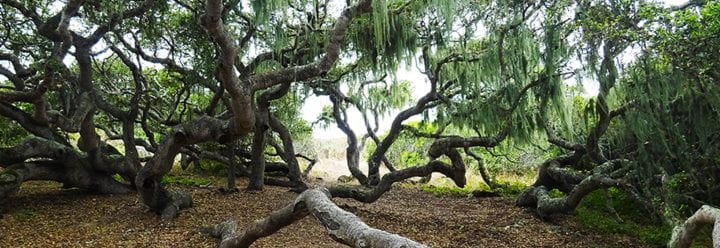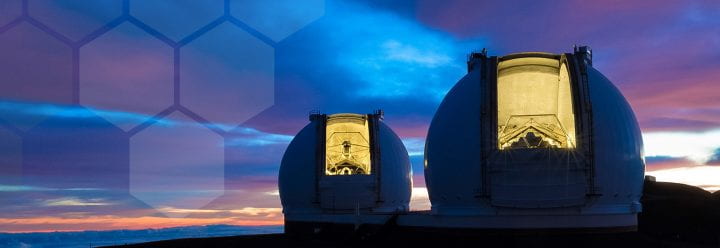Some of the most pivotal scientific discoveries during the last 50 years have been made by the UC Santa Cruz Division of Physical & Biological Sciences. Connect with our high-impact research labs, facilities, and natural reserves responsible for advancing human knowledge by using the filters below.
There were no results found for your filters.

The 25-acre reserve is a premier living laboratory with access to an incredible diversity of marine animals. It serves as an international hub for research, student experiences, and public outreach.

The AII initiative promotes interdisciplinary research using machine learning and artificial intelligence, attracts and trains a diverse student population, and forges partnerships with industry.

The UC Santa Cruz Astrobiology Initiative launches in 2020.

The BioMed facility provides flexible laboratories for researchers in molecular biology, chemistry, toxicology, and biomolecular engineering. The building is LEED Gold Certified and winner of the 2015 AIA SF Design Award.

The reserve supports hands-on education, research, and stewardship on 410 acres of protected land. Projects include ecological monitoring, forest ecology research, and land management.

The MWVCRC is a primary care facility for southern sea otters affected by oil spills or other marine pollution events. The facility also supports a wide-array of marine wildlife research in California.

The center hosts ~55,000 compounds from commercial sources and natural products dedicated to human health and finding the next generation of therapeutic agents against a wide variety of diseases.

The CBB facility supports research and teaching in coastal conservation, ecology, habitat restoration, climate change impacts, and policy. The building is LEED Gold Certified.

The 100-acre CSC campus is located on the edge of the Monterey Bay National Marine Sanctuary, encompassing research and educational facilities that support coastal conservation, marine biology, ecology, and environmental policy.

The EMS facility provides wet laboratories, cleanrooms, office space, and lecture halls for researchers and students in Earth & planetary sciences, ocean sciences, and marine sciences.

FCP advances the science of fisheries ecology and resource management, conducts comprehensive studies on the conservation of threatened and endangered species, and leads research that supports sustainable, globally-impactful fisheries initiatives.

The 600-acre reserve supports long-term climate change research and transformative field experiences designed to inspire a new generation of natural scientists, from K-12 to college students.

The greenhouse facilities provide research and instructional support for plants used in ecology and evolutionary biology, molecular, cellular and developmental biology, and environmental studies.

The ISB facility provides office space, classrooms, and computer labs for researchers and students in astronomy & astrophysics, Earth & planetary sciences, physics, and environmental sciences.

The LML laboratory uses a 1,000 GPM seawater delivery system for research in coastal ecology, marine vertebrates and invertebrates, animal physiology, sensory reception, behavior, and bioacoustics.

The LAO laboratory enables research, development, assembly, and deployment of adaptive optics systems for the next generation of high-resolution astronomy instrumentation on the world's largest telescopes and complex satellites.

The reserve protects several miles of rugged, rocky shorelines, which flank the Pacific Ocean and extends approximately one mile offshore. Its purpose is to support teaching, research, and public service.

The facility is the world's first permanently occupied mountain-top observatory. The observatory has been responsible from some of the most significant discoveries in the history of astronomy since 1888.

The MSFCF facility supports biochemistry and structural biology researchers with state of the art instrumentation, supplies, and expertise to assist in the structural characterization of biological macromolecules.

The plasma laboratory hosts scientific instrumentation and consultation to support research in marine-related research. Major equipment includes chromotography and spectrometer systems, carbon and nitrogen analyzers, and fluorometers and nutrient analyzers.

The network advances science, education, and public awareness of marine mammals and ocean health through response and detailed examination of stranded marine mammals, both dead and alive.

The facility currently houses a LC-MSLTQ and LTQ-Orbitrap Velos Pro MS. The new orbitrap provides high-mass accuracy in full ion scan and MSn modes accompanied by substantial resolving power.

The MSEI initiative brings together experts in materials synthesis, characterization, and theoretical modelling to accelerate the fundamental knowledge and workforce training required to develop new materials used in sustainable technologies.

The facility offers instrumentation and support for scientists who require methods and instrumentation to collect real-time microbial, environmental, and genomics data from the ocean via remote processing and sensing.

The facility serves our biological research community, providing personalized assistance on various aspects of imaging, from experimental design to training on the shared microscopes to image analysis.

Proudly doing our part to increase COVID-19 diagnostic testing capacity in Santa Cruz. Effective May 1, 2020, the lab is approved as a temporary testing site by the California Department of Public Health under CLIA certificate of accreditation – CDF-00002057, CLIA # 05D0687329.

MBAMP offers professional development opportunities for K–12 teachers in Santa Cruz, Monterey, and San Benito counties.

The facility manages three high resolution NMR spectrometers engaged in structural elucidation of anticancer natural product isolation from marine organisms, organic intermediates for drug synthesis, and more.

The NOAA SWFSC faculty supports research on California demersal and anadromous fishes, their fisheries, and their habitats.

The 23,000 sq. ft. facility supports research and teaching for vertebrate and invertebrate coastal biology and ecology, as well as marine conservation and policy.

The OWL laboratory is a new research initiative that seeks to understand Earth’s place in the diversity of our solar system using state-of-the-art techniques to find planets around other stars (“exoplanets”).

The PSB facility supports classrooms, conference rooms, administrative offices, and 50 highly specialized laboratories customized for trace metal research, flammable storage, controlled environment rooms, darkrooms, and laser research.

The pinniped laboratory explores the sensory, cognitive, physiological, and behavioral ecology of marine mammals by studying individuals in controlled and natural settings.

The group promotes conservation of predatory birds and environmental education. Current research programs include raptor banding and survey efforts in the San Francisco and Monterey Bay Areas.

The S&E library is located on Science Hill of main campus. Recent renovations have created a comfortable study environment to support academic success through active learning spaces and new technologies.

The group includes world experts on earthquakes, mantle structure, subduction zones, tsunamis, and exploration imaging. They develop new techniques to map the Earth's subsurface and unravel the workings of earthquakes.

A community-supported marine science education center dedicated to educating people about the role scientific research plays in understanding and protecting the world’s oceans.

The Sinsheimer facility supports research offices and highly specialized laboratories and cleanrooms customized for molecular biology, chemistry, toxicology, and biomolecular engineering research.

The SIL laboratory provides a suite of spectrometers and databases that support isotopic analyses for a wide range of research disciplines, including oceanography and earth science, paleontology, anthropology, ecology, and biochemistry.

The S-Lab provides functional indoor and outdoor research laboratories, workshops, prototyping and test equipment, meeting rooms and gathering spaces that encourage creativity and an entrepreneurial mindset.

The UCO laboratories host a collection of technical and mechanical manufacturing tools for the production of instruments, electronics, adaptive optics, and components used in the world’s most powerful satellites and telescopes.

The facility is home to the world’s most scientifically productive optical and infrared telescopes. The twin observatories have 10-meter mirrors composed of 36 hexagonal segments that operate with nanometer precision.

The laboratory comprises three mass spectrometers, automated sample purifiers, and wet chemical labs all housed in a class 1000 suite of clean labs.

The laboratory offers state of the art diffraction instrumentation for detailed structural analyses utilizing single crystal, powder and thin film diffraction techniques.

The 72-acre reserve is considered one of the few relatively undisturbed wetlands remaining on the California Central Coast, making it a valuable living laboratory for researchers and students studying ecology.
